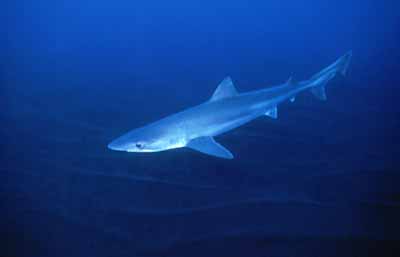
|
|
|
|
|
|
Shark Info (03-27-2002) |
Author |
|
Intro: |
Shark Info |
|
Main article: |
Dr. Thomas Althaus |
|
Article 1: |
Shark Info |
|
Article 2: |
Shark Info |
|
Article 3: |
Shark Info |
|
Article 4: |
Shark Info |
|
Article 5: |
Shark Info |
|
Fact Sheet: |
Shark Info |
|
Fact Sheet: Tope shark
DescriptionThis is a typical houndshark or tope shark with almond-shaped eyes and a long snout. The second dorsal fin is considerably smaller than the first and is about the same size as the anal fin which lies immediately opposite. ColorThe shark's upper body is bronze to taupe-colored and its belly is pale white. Biology
Houndsharks are active and fast swimmers who prefer to stay mainly in coastal regions. They
also live partly pelagic, but not oceanic , preferring waters between 2 and approx. 470
meters deep. Often swimming in schools, they demonstrate highly migratory behavior and have
been proven to master distances of 2,500 km. Observations have shown that outside the
mating season, males and females prefer to live separately. SizeThese sharks reach a maximum size of 195 cm, except for animals found near Australia who are somewhat smaller with 175 cm. FeedingHoundsharks have a broad food spectrum, preferring bony fish such as herring, sardines and codfish. In addition to feeding on freely swimming fish and those who live on the ocean floor, they also eat crabs and other invertebrates. ReproductionHoundsharks bear their young alive and have no placenta (ovoviviparous). Their litters can range from 6 and 52 pups, but are usually between 20 and 35. The pups are 30 to 40 cm long at birth. Males reach sexual maturity around age 8 (with a body length of 120 to 170 cm), and females at age 11 (with a body length of 130 to 185 cm). Their life span is said to be about 55 years. DistributionSouthwestern Atlantic: south of Brazil to Argentina. Eastern Atlantic: Iceland, Norway, Faeroe Islands and Great Britain. Entire Mediterranean area. Senegal, it is questionable if it is found further south along the Western coast of Africa, certainly however in South Africa. Western South Pacific: Australia (western and southern regions), New Zealand. Central Pacific: Laysan Islands. Eastern Pacific: British Columbia to southern Baja California, Peru and Chile. Similar SpeciesTheir very typical shape makes them easily recognizable and not likely to be confused with other species. Danger to humansDue to their maximum size of less than two meters, tope sharks pose no threat to humans. GefährdungAs the English translation of their name "soupfin shark" already suggests, many houndshark populations are endangered because they are strongly overfished. The soupfin shark in California, for example, has been practically wiped out. May be published only by indicating the source: Shark Info |
|
|
|
|
|
|||||
